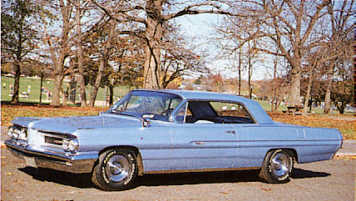Occupants of the car were treated to a sporty but luxurious interior, boasting such niceties as Morrokide-covered bucket seats, console, floor shift, tachometer, and rear speaker. This upscale interior easily rivaled anything the competition could serve up.
A photo of a late preproduction prototype shows almost all of the trim pieces that eventually made production, but bearing the Ventura nameplate. It appears as though the Grand Prix name may have been reserved for a proposed Pontiac version of the new GM E-body that was being developed. Originally intended to be the 1963 La Salle II, the car was rejected by Cadillac, and was then up for grabs. Eventually, the E-body proposal became the Buick Riviera. Apparently, when Pontiac executives ruled out the possibility of getting the E-body, they replaced the "Ventura" name with "Grand Prix."
The overall effect of the new car was striking. It sat an inch lower than its B-body siblings, although it appeared to be even lower, mostly due to the absence of chrome. Topped off with the optional Kelsey-Hayes 8-lug integral wheel/brake-drum sets, the '62 GP was about the slickest thing on the road. But there was much more to it than just looks.
A variety of engines was available, from mild to wild. The base engine was a 303-hp 389 4-barrel mated to a choice of 3-speed, 4-speed, or automatic transmissions. And you could order engines up or down the horsepower scale. If economy was a priority (who in their right mind was thinking about mileage back then?), a 230-horse, low-compression 389 2-barrel was available, though only with the automatic.
If you were a bit more adventurous, hotter engines were just a check of the option list away. Next up the ladder from the standard engine was the "regular" 389 Tri-Power. It developed 318 horses at 4600 rpm with 10.75:1 compression, again with manual or automatic gearboxes.
The heat really got turned up in the 425-A Trophy V8 series. These mills differed from the other 389s by virtue of their four-bolt main caps, lower block reinforcing ribs, and longer-duration cam. The single 4-barrel version was rated at 333 hp, while the Tri-Power Trophy carried a 348-hp rating. For part of the year, these two were the top engine options, but then 421 Super Duty production gained momentum. As it turned out, only 16 Super Duty Grand Prixs were produced. Of those, only one is known to have survived. It is a steel-fendered burgundy and parchment car, now owned by Allan Gartzman of Skokie, Ill.
There has been some confusion going on for a number of years regarding the availability of a non-SD street 421 engine for the '62 Grand Prix. Here's the story: According to Fred Simmonds, Orlando zone representative for Pontiac, it was an unpublicized substitute option that appeared very late in the 1962 model year--so late, in fact, that some of the engines built are reputed to have been early 1963 421 HOs. The 421s were supposedly substituted in place of the 389 Trophys, which were dropped toward the end of the year.
Interestingly enough, this "street" version of the 421 was only rated at 320 horses and carried the 29J code, which for some reason never was included in any engine code listings. Seventy-five of these engines were reportedly built, and factory records indicate that 67 1962 GPs were fitted with them. All of them were automatic 4-barrel cars. Simmonds notes that there is no pattern to the ordering of these cars. They were not built at once, and came in all colors. Some were strippers and some were loaded.
 
1962 Grand Prix Coupe. |
Pontiac built 30,195 production Grand Prixs for 1962, all hardtops. The company did, however, build one 1962 Grand Prix convertible show car. Dubbed the X-400, it was the third car to bear that name. X-400 Bonnevilles had been built for 1959 and 1960 (see HPP, April 1989, page 34). The '62 was painted a brilliant red, set off with a white convertible top and 8-lug wheels. Its many deviations from stock included rectangular headlights with chrome mesh covers, a special hood ornament, a louvered hood, a fiberglass tonneau cover, and unique exhaust ports in the rear quarter panels.
The interior sported many custom features, including a wood steering wheel and thin-shell bucket seats. Where the radio would have been, instead resided a boost pressure gauge, a tachometer, and a clock. A nonproduction console was also used. It housed the relocated radio, the shifter, and a lever that controlled an exhaust bypass. This lever had three settings: fully closed, partially closed, and fully open. When the car was taken to the drag strip, there was no need to get underneath to uncork the exhaust system.
Under the hood of the X-400 was a full-tilt 421 with a 6-71 blower that was fed by four 1954 Corvette side-draft carbs. The huffer produced 7 pounds of boost with a rather hefty compression ratio of 10.25:1. With a 4.88:1 gear rato, the 4,750-pound car turned a 14.93 ET in the quarter at 97.78 mph with the great Mickey Thompson at the wheel. Mickey is also credited with the X-400's wild induction system, which was similar to the one on his drag and land-speed-record Ponchos.
NEXT >
|
|